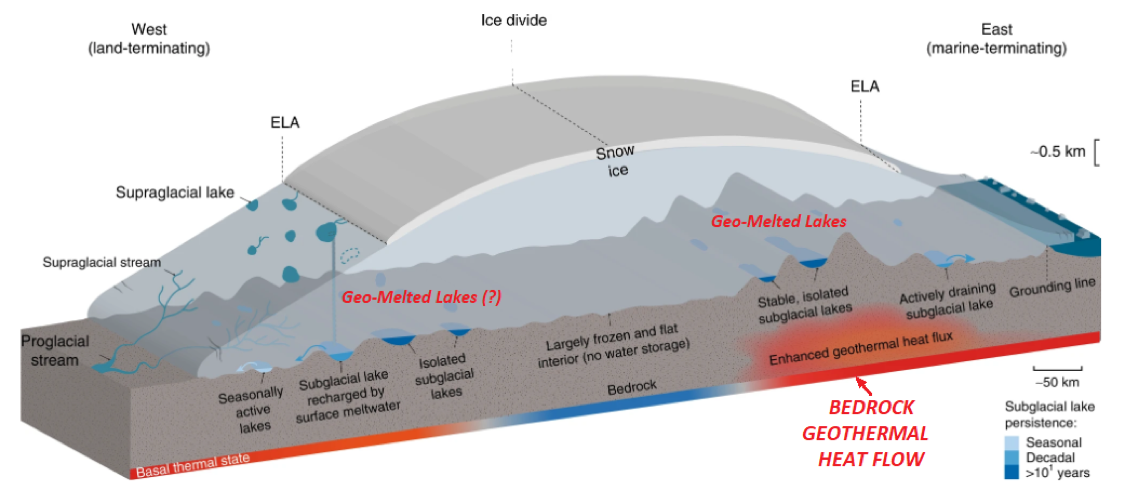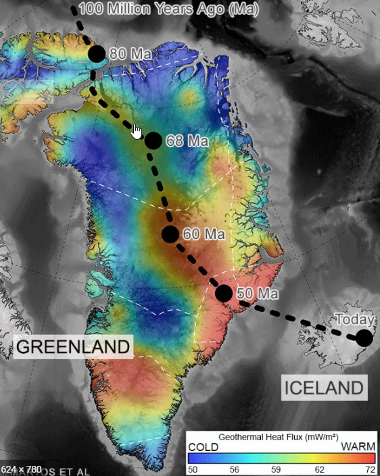Written by James E. Kamis 6OCT2019
Figure 1. Illustration of ice melting and subglacial lake forming and anomalously high bedrock geothermal heat flow (light red shading) located beneath Greenland’s Ice Sheet (Image credit: the University of Lancaster and University of Sheffield, red labels by J. Kamis)
Yet another major research study, five if you are counting, has concluded that much of the accelerated melting at the base of Greenland’s glacial ice sheet is from anomalously high geothermal heat flow. High heat flow, according to the combined areas of the four previous studies (NASA, Aarhus University, University of Kansas, University of Maryland), is present beneath 50% of the world’s second-largest ice sheet as shown in Figure 2 (cross-hatched red). Figure 2 shows outlines of above-sea-level high-bedrock heat-flow areas bordering or in Greenland.
The reader is directed to previous Climate Change Dispatch articles that summarize the results of four research studies and their impact on Arctic climate and climate-related events see here, here, here, and here.
Figure 2. Above sea level geological hotspots (cross-hatched red) and major deep earth reaching fault zones termed Rifts.
Now onto the discussion of the just-released research study by the University of Lancaster and University of Sheffield. Research that established for the very first time the existence of an estimated fifty-four subglacial lakes beneath Greenland’s vast glacial ice sheet. Study researchers attributed the generation of these lakes to numerous factors, most notably geothermal high-bedrock heat flow that the authors term “enhanced geothermal heat flux.” This study and other information can be utilized to formulate a detailed explanation of exactly how bedrock heat flow generates Greenland’s subglacial lakes:
All the various types of subglacial lakes highlighted in Figure 1 are in long, linear bedrock valleys. This geological configuration is indicative of valley generation by long, linear faults, some of which uplift long, linear hills and others which act to down drop long, linear valleys. This quite common geological process acts to form long, linear water catchment basins worldwide.
It is here we argue that these long, linear fractured fault planes, especially the highly active ones, tap downward into deep and thereby higher temperature geothermally heated rocks. This acts to provide a vertical conduit for this elevated heat area upward onto areas adjacent to the fault plane / overlying glacial ice interfaces. Heat flow that acts to bottom-melt glacial ice that supplies meltwater to fill four-way closed catchment basins.
The researchers so-called “isolated” subglacial lakes designation (Figure 1) is an admission that they could not establish a connection of subglacial lakes to overlying glacial ice surface meltwater. It is here hypothesized that this so-called isolation is an indication of areas where the fault induced heat flow has not yet punched upward to the glacial ice / atmospheric interface. Non-isolated long linear subglacial lakes with a connection to the glacial ice / atmospheric interface are areas where the fault induced heat flow aided by fault induced fracturing of the overlying ice has punched through to the glacial ice / atmospheric interface.
Further proof of fault involvement in subglacial lake development is demonstrated on the researchers’ Figure 3, which illustrates the long linear straight alignment of multiple subglacial lakes (red line) which perfectly match known fault trends (red line) in this area.
Other discussions of Greenland high bedrock heat flow can be found here, here, and here.
A just-released geological study by the University of Kansas (UK) has confirmed the results of three previous studies (see here, here, here, and here). All four of these studies concluded that geothermally heated bedrock is the dominant and likely sole cause of anomalous Greenland ice sheet melting. The UK study is especially convincing because it includes historical data, newly acquired data, and a very thorough analysis by a highly regarded non-biased research institution.
Figure 3. Greenland present day bedrock heat flow (shaded) and tract of Greenland across a stable Mantle Plume which is a geological term for a deep earth hot lava chamber (black dotted line).
The presence of Greenland subglacial bedrock geologically induced heat flow comes as no surprise because geologists and collaborating scientists been aware of this heat flow for many years. The question has always been what force generated this heat. NASA and others found the answer which is illustrated on Figure three. It is the result of two geological features. Relic bedrock heat from an ancient Mantle Plume which is a deep earth hot lava chamber and present-day heat flow from a highly subglacial fault trend.
A 1,000-mile-long south to north flowing subglacial river system has been identified by research by Hokkaido University, et.al. (see figure below). The position of this river system exactly matches the ancient movement across a deep earth hot spot, the Greenland / Iceland Mantle Plume (see here). The course of the subglacial river system also coincides and is controlled by with long linear faults of Greenland's interior basin faults (see here).
Figure 4. The above two images compare a recently mapped 1,000-mile-long river beneath Greenland's ice sheet (upper Image) and high-resolution bedrock topography of Greenland.
The above Figure 4 images demonstrate that there is a strong the relationship between a 1,000-mile-long subglacial river (upper image) and faults in Greenland's bedrock topography (lower image). The author believes that these long linear faults control the position of the river.
In summary, a significant amount of information is here interpreted to show that most of Greenland's glacial melt is the result of currently heat flow from subglacial bedrock geological features. As is true with all geologically heat flow active geological features the magnitude and duration of the heat flow varies through time even within the last 50 to 100 years. As a result, it is quite possible, in fact likely that increases or decreases in this heat flow is the root cause of accelerated or decelerated glacial ice melting.






